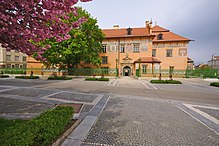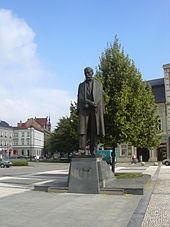Prostějov
| Prostějov | ||||
|---|---|---|---|---|
|
||||
| Basic data | ||||
| State : |
|
|||
| Historical part of the country : | Moravia | |||
| Region : | Olomoucký kraj | |||
| District : | Prostějov | |||
| Area : | 4658 ha | |||
| Geographic location : | 49 ° 28 ' N , 17 ° 7' E | |||
| Height: | 223 m nm | |||
| Residents : | 43,680 (Jan 1, 2019) | |||
| Postal code : | 796 01 | |||
| structure | ||||
| Status: | Statutory city | |||
| Districts: | 8th | |||
| administration | ||||
| Lord Mayor : | František Jura ( ANO ) (as of 2018) | |||
| Address: | nám TG Masaryka 12-14 796 01 Prostějov |
|||
| Municipality number: | 589250 | |||
| Website : | www.mestopv.cz | |||
Prostějov ( German Proßnitz in Moravia ) is a town in the Olomouc region in the Czech Republic . It is the district town of the Prostějov district .
geography
Prostějov is located in the Moravian Hanna plain , 18 km southwest of Olomouc at 223 m above sea level. The confluence of the Romže and Hloučela rivers is located near the town .
City structure
Prostějov includes the following districts:
- Čechovice ( Chekhovitz ) - 1050 Ew.
- Čechůvky ( Czechuwek ) - 163 Ew.
- Domamyslice ( Domamislitz ) - 1056 Ew.
- Krasice ( Krassitz ) - 2046 Ew.
- Vrahovice ( Wrahowitz ) - 3402 Ew.
- Žešov ( Scheschow ) - 325 Ew.
history
The place was first mentioned in 1141 as a settlement Prostějovice . The name Proßnitz has been documented since 1213. It was already a market village before 1300. From 1390 a fair was allowed to be held, which was equivalent to an elevation to the city. At that time the place belonged to the Lords of Kravarn and was part of the Plumlov reign . Since the city supported the Hussites during the Hussite Wars , it was sacked and pillaged by the Catholics in 1431. The other owners of the estate were Messrs Pernstein from 1495 to 1599 and the House of Liechtenstein from 1599 to 1848 . In 1857 the population was "Moravian and German language".
In the 19th century, Proßnitz is the seat of a district administration and a district court and at that time had four suburbs, a German and a Czech high school, a weaving school, a city hospital and a hospital of the Barmherzigen Brüder, gas lighting and 18,417 residents (1880), including 1,800 Jews . In 1892 a Czech, Karel Vojáček, was elected mayor for the first time. By 1900 Proßnitz already had 25,466 predominantly Czech residents.
After the occupation and annexation by the German Reich , the city was the seat of the district of Proßnitz until 1940. Thereafter, until 1945, the Proßnitz district was part of the Mährisch Ostrau district councilor .
After the end of the Second World War and the German occupation, the German-speaking residents of the city were expelled in 1945. In an exchange of fire with the Warsaw Pact intervention troops in 1968, during the so-called Prague Spring , three people died. In 1990 the historic city center was declared a monument protection zone. The city is now the center of the Czech textile industry .
In 2012 Prostějov was elevated to a statutory city .
Demographics
| year | Residents | Remarks |
|---|---|---|
| 1837 | 8,552 | excluding the Jewish community (1,742 inhabitants in 58 houses), in 778 houses, except for three Evangelicals all Catholic residents who speak both national languages |
| 1854 | 11,174 | Moravian and German-speaking Catholics along with 2,000 Jews |
| 1857 | 12,542 | |
| 1880 | 18,417 | including 1,800 Jews |
| 1900 | 25,466 | with the independent Israelite community, mostly Czech residents |
Garrison town
The place was a garrison of the following military units:
- Cuirassier Regiment No. 5 (1798–1799)
- Kuk Dragoon Regiment "Kaiser" No. 11 (1832–1846)
- Kuk Hussar Regiment "Graf Nádasdy" No. 9 (1847)
- Kuk Dragoon Regiment "Friedrich Franz IV. Grand Duke of Mecklenburg-Schwerin" No. 6 (1848–1849)
- Imperial and Royal Hussar Regiment "Kaiser" No. 1 (1849–1852)
- Kuk Dragoon Regiment "Count Montecuccoli" No. 8 (1855-1859)
- Kuk Hussar Regiment "Arthur Duke of Connaught and Strathearn" No. 4 (1861–1866)
- Imperial and Royal Hussar Regiment "Friedrich Leopold of Prussia" No. 2 (1866–1870)
- Kuk Dragoon Regiment "Kaiser Franz I." No. 1 (1870–1871)
- Kuk Dragoon Regiment "Nikolaus Nikolajewitsch Grand Duke of Russia" No. 12 (1871–1879)
- Kuk Uhlan Regiment "von Böhm-Ermolli" No. 13 (1879–1883)
- 2nd / 3rd Squadrons of the 4th Landwehr Uhlan Regiment (1890)
During the Second World War, the following were stationed at the Kosteletz Air Base near Proßnitz:
- 1944: Attack Aircraft Supplementary Group 154
- August 1944 - February 1945: IV./Schlachtgeschwader 151
- December 1944: 5./Jagdgeschwader 300
- January 1945: I. and II./Jagdgeschwader 77
As a garrison of the armed forces of the Czech Republic
- Since 2003 601. skupina speciálních sil generála Moravce . In the previous organizational structures since 1960.
Attractions
- Prostějov Castle
- Parish Church of St. Exaltation of the cross ; it was built in 1391 by the Lords of Krawarn for the Augustinian Canons ; Burned out in 1421 and 1697; last rebuilt in neo- baroque style.
- Plague column from 1714 with the statue of the Virgin Mary
- Baroque church of St. John of Nepomuk , and the Monastery of the Brothers of Mercy
- Peter and Paul Church with the baroque chapel of St. Lazarus
- Church of St. Cyril and Method
- Volkshaus “Národní dům” - an imposing Art Nouveau building; Built 1905–1907 based on a design by the architect Jan Kotěra .
- Old Town Hall - Renaissance building from the years 1521–1530
- New Town Hall - built between 1911 and 1914 based on a design by the Brno architect Karel Hugo Kepka.
Personalities
sons and daughters of the town
- Jan Filipec (1431–1509), Bishop of Oradea and administrator of Olomouc
- Matěj Rejsek (around 1445–1506), Gothic stonemason and builder
- Veith Ehrenstamm (1763–1827), industrialist
- Gideon Brecher (1797–1873), doctor and writer
- Wenzel Messenhauser (1813–1848), officer and writer
- Moritz Steinschneider (1816–1907), orientalist and founder of the modern Hebrew bibliography
- Johann Nepomuk Berger (1816–1870), politician, writer and lawyer
- Franz Kuhn von Kuhnenfeld (1817–1896), Reich Minister of War
- Adolf Beer (1831–1902), historian
- Eugen Felix (1836–1906), painter
- Max Fleischer (1841–1905), architect
- Ignaz Brüll (1846–1907), Austrian composer and pianist
- Alois Czerny (1847–1917), folklorist
- Georg Schmiedl (1855–1929), teacher and founder of the Friends of Nature movement
- Konrad Loewe (1856–1912), actor and playwright
- Richard Mandl (1859–1918), Austrian composer
- Edmund Husserl (1859–1938), philosopher, founder of phenomenology, married to Malvina Charlotte Steinschneider
- Richard Stein (1871–1932), publisher
- Arthur Scheller (1876–1929), astronomer
- Rudolf Alfred Höger (1877–1930), Austrian genre and war painter
- Pankraz Schuk (1877–1951), Austrian writer
- Franz Fiedler (1885–1956), photographer
- Vladimír Ambros (1890–1956), composer
- Carmen Cartellieri (1891–1953), actress
- Max Zweig (1892–1992), playwright
- Emanuel Kaláb (1895–1982), Czech military bandmaster, conductor and composer
- Jiří Wolker (1900–1924), poet
- Bernhard Heilig (1902–1943), economist and historian
- František Wolf (1904–1989), mathematician
- Josef Mach (1909–1987), director
- Otto Wichterle (1913–1998), chemist, inventor of the contact lens
- Susi Weigel (1914–1990), Austrian children's book illustrator
- Josef Polišenský (1915–2001), Czech historian
- Alexej Pludek (1923–2002), writer and politician
- Jirina Prekop (* 1929), psychologist
- Milena Dvorská (1938–2009), actress
- Vladimír Körner (* 1939), screenwriter, dramaturge and writer
- Petr Chudozilov (* 1943), writer
- Rostislav Václavíček (born 1946), football player
- Oldřich Machač (1946–2011), ice hockey player
- Vladimír Vačkář (* 1949), track cyclist
- Vlastimil Petržela (* 1953), football player and coach
- Ladislav Svozil (* 1958), ice hockey player
- Luděk Mikloško (* 1961), football player
- Petr Hořava (* 1963), physicist
- Karel Nováček (born 1965), tennis player
- Paulina Porizkova (* 1965), actress
- Robert Změlík (* 1969), Olympic champion in the decathlon
- Martin Richter (* 1977), ice hockey player
- Jindřich Skácel (* 1979), football player
- Petr Kumstát (* 1981), ice hockey player
- Lukáš Krajíček (* 1983), ice hockey player
- Petra Cetkovská (* 1985), tennis player
- Pavel Dreksa (* 1989), football player
- Jakub Čech (* 2000), journalist and activist
They lived and worked in the city
- Jan Černý (around 1456–1530), doctor and priest
- Johann von Pernstein (1487–1548), governor of Moravia
- Meir Eisenstadt (1670–1744), Rabbi
- Jonathan Eybeschütz (1690–1764), Rabbi
- Jan Alois Hanke (1751–1806), Moravian enlightener, historian, writer and humanist
- Carl Techet (1877-1920), satirical writer
- Arnold Korff (1870–1944), Austrian actor
- Leo Lehner (1900–1981), Austrian composer
Partnerships
- Town twinning
- Borlange (Sweden)
- Środa Wielkopolska (Poland)
- Hoyerswerda (Germany)
- Vysoké Tatry (Slovakia)
- St. Pölten (Austria)
- schools
- School partnership between the Gymnázium Jiřího Wolkera Prostějov and the Léon Foucault High School Hoyerswerda (since November 7, 2009)
- School partnership between the Základni Skola a Materská Skola Prostějov and the primary school "An der Elster" and the secondary school "Am Stadtrand", both in Hoyerswerda (since November 7, 2009)
traffic
The main station is on the Moravian-Silesian Northern Railway . The Prostějov city station is also on the Nezamyslitz-Olmütz-Sternberg lines of the Kaiser Ferdinands-Nordbahn and Proßnitz-Triebitz (78 km) of the Moravian Western Railway.
The R46 expressway ( Rychlostní silnice 46 ) is the direct connection to the D1 motorway. The international Bernsteinstrasse cycle route also runs through the city.
Sports
In 1999 the international tennis tournament WTA Prostějov and some games of the U-16 European Football Championship took place in Prostejov . In 2001, the Group F games of the IIHF Continental Cup 2001/02 were played in the city. At the beginning of June, the Czech disco dance championships will also take place here.
- HK Jestřábi Prostějov (ice hockey)
- SK Prostějov (soccer)
- BK Prostějov (basketball)
- VK Prostějov (volleyball) - in the 2010/11 Volleyball Champions League (women)
Web links
- City website in Czech, German, English
Individual evidence
- ↑ Český statistický úřad - The population of the Czech municipalities as of January 1, 2019 (PDF; 7.4 MiB)
- ^ A b Gregor Wolny : Church topography of Maehren . Part I: Olmuetzer Erzdioecese , Volume 2, Nitsch and Gross'esche Buchhandlung, Brünn 1857, p. 2
- ^ Gregor Wolny : The Margraviate of Moravia, portrayed topographically, statistically and historically . Brno 1839, p. 671 .
- ^ Carl Kořistka : The Margraviate of Moravia and the Duchy of Silesia in their geographical relationships . Vienna and Olmüz 1861, pp. 268–269 .
- ^ Meyer's Large Conversational Lexicon . 6th edition, Volume 16, Leipzig and Vienna 1908, p. 389.









